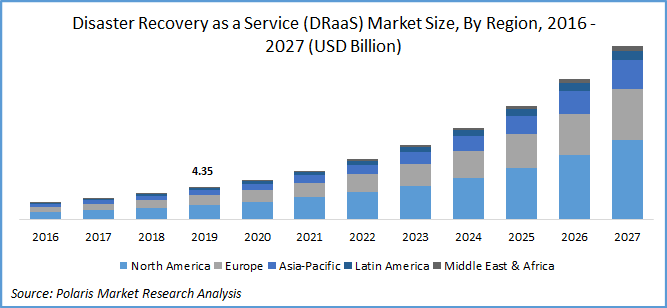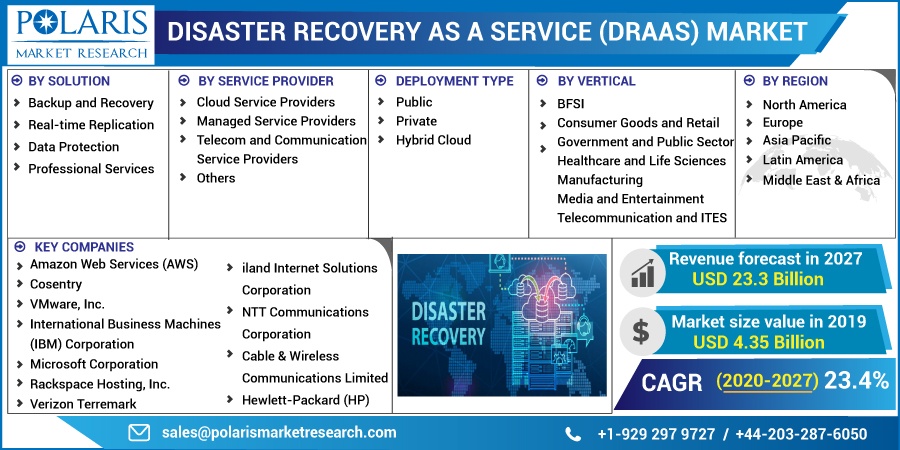
Disaster Recovery as a Service (DRaaS) Market Share, Size, Trends, Industry Analysis Report, By Solution (Backup and Recovery, Real-time Replication, Data Protection, Professional Services); By Service Provider; By Deployment Model; By Vertical; By Regions; Segment Forecast, 2020 - 2027
- Published Date:Dec-2020
- Pages: 101
- Format: PDF
- Report ID: PM1775
- Base Year: 2019
- Historical Data: 2016 - 2018
Report Summary
Global Disaster Recovery as a Service (DRaas) market was valued at USD 4.35 billion in 2019 and is expected to grow at a CAGR of 23.4% during the forecast period. DRaaS is a category of cloud computing that protects and recovers the data from any human or natural disaster. Enterprises, SMBs, and consumers need to protect their data to ensure business continuity at all times.
The Disaster Recovery as a Service (DRaaS) market is based on the two most important parameters that include the Recovery Time Objective (RTO) and Recovery Point Objective (RPO). RTO measures the amount of downtime a business can avail without incurring any significant loss. The downtime may vary from hours, days, and weeks depending on the business requirement and functioning. RPO measures an organization’s tolerance at the time of data loss during application downtime. RPO enables the system administrators to predict the amount of downtime and decide which backup & recovery technologies would not delay the normal operations.

Know more about this report: request for sample pages
The solutions provided through the cloud minimize the operational and capital expenditure incurred. The business continuity of the enterprise depends on the Service-Level Agreement (SLA) made between the supplier and the end-users. The SLA enables the users to ascertain the amount of downtime and have a backup of their data virtually on a hosted machine. The cost associated at the time of making SLA depends on the amount of data that needs to be stored virtually in case of any emergency and failure. The cloud-based DRaaS enables the customers and the enterprises to store the data and run their systems on the cloud. The migration to cloud-based disaster recovery cuts the recovery process and enables significant savings. The disaster recuperation on the cloud must include networking, failover, and automated testing to ensure business continuity every time in case of a natural or man-made disaster.

Know more about this report: request for sample pages
Industry Dynamics
Growth Drivers
DRaaS enables faster recuperation of the lost data due to natural or manmade disasters and minimizes the amount of downtime. The enterprises cannot let the disaster cause any delay and downtime that can adversely affect their productivity. Faster recuperation is the key for any enterprise to achieve long-term success and gain a competitive advantage. Recovery time objective and recovery point objective have enabled the enterprises to know the amount of downtime and accordingly plan their backup of critical data and minimize the amount of downtime. The traditional disaster revival method such as back-up tape adopted by the enterprises was time-consuming; this further pushed the enterprises to adopt less expensive DRaaS solutions that provide faster recovery.
The traditional disaster recovery site runs on the hardware components such as infrastructure, servers, storage, network, and others that are expensive. The enterprises running on traditional sites need to invest a huge amount in the maintenance of the infrastructure. The recovery time in the traditional disaster recovery sites can also go on for days, which further hampers the efficiency of the enterprises. These reasons open the platform for cloud-based platforms that reduces the overall costs significantly and utilize the on-premises resources for other important projects. The pay-as-you-go model has also reduced the cost of the enterprises to a great extent as the enterprises need to pay only for the amount of usage done.
Disaster Recovery as a Service (DRaaS) Market Report Scope
The disaster recovery as a service market is primarily segmented on the basis of solution, service provider, deployment type, vertical, and region.
|
By Solution |
By Service Provider |
Deployment Type |
By Vertical |
By Region |
|
|
|
|
|
Know more about this report: request for sample pages
Insight by Solution
Based upon the solution, the global Disaster Recovery as a Service (DRaaS) market is bifurcated into Backup & Recovery, Real-time Replication, Data Protection, and Professional Services. In 2019, the back-up recovery segment is the largest revenue share. This is since the backup of historical data, file-level data, and documents are the most crucial to recover in case a disaster happens.
Restoring the data from the hard drive or servers is expensive and time-consuming; therefore, most enterprises are moving toward the backup as a solution. An efficient cloud backup solution offers numerous benefits such as synchronizing folders, easily accessible web view files, streaming of the files, and others. The cloud-based backup also provides unlimited and hassle-free storage, which further increases the efficiency and productivity of the employees. By having a cloud-based backup solution, file management becomes easier and all the data gets stored automatically in real-time.
Real-time replication is projected to exhibit the highest growth rate over the study period. The real-time solution reduces the complexities involved in disaster recovery, protects the applications, and reduces costs. Most of the IT administrators of the enterprises now store the data on an isolated platform so that the complete data gets replicated automatically. This enables the enterprises to access the data from the hosted or virtual machines in case disaster strikes and further continue their operations without any delay.
Insight by Service Provider
Based on service provider, the global Disaster Recovery as a Service (DRaaS) market is bifurcated into cloud platform providers, managed providers, telecom and communication providers, and others. In 2019, the managed providers segment accounted for the largest market share. Managed providers are responsible for managing and monitoring IT systems on behalf of their clients. These services are becoming more popular in the DRaaS market as they reduce monitoring and security cost. IBM, Windstream, and HCL Technologies are some of the companies that offer high-end managed services catering to all the major industry verticals across the geography.
Insight by Vertical
In 2019, the BFSI segment accounted for the largest market share. Banking, financial services, and the insurance industry are the most concerned industries when it comes to data security and compliance. Ensuring security and privacy and the ability to manage and control information play a very vital role in implementing cloud-based disaster recovery in the BFSI market segment. The security personnel also need to ensure firewalls and perimeter protection devices are updated and operational in the financial institutions. An insurance company may lose its client data anytime within its SLAs, which further affects the relationship between them. BFSI is expected to be the leading vertical in adopting DRaaS advanced technologies and innovation. DRaaS solutions offer flexible and adaptable hybrid infrastructure, better performance, and scalability features.
Geographic Overview
DRaaS market has been segmented on the basis of regions, North America, Europe, APAC, MEA, and Latin America. Among these five regions, enterprises in North America and Europe market are the regions that have adopted cloud at a very early stage, and hence their technical skills and expertise in the cloud domain are much higher than their counterpart in APAC, MEA, and Latin America. However, Latin America, APAC, and MEA have emerged as the regions with a very high adoption rate. In the era of globalization, for enterprises in LA, APAC, and MEA it has become inevitable to stay behind in the technological marketspace. As their businesses are growing, these enterprises want to focus more on main business generating operations. For such enterprises, outsourcing of technological activities and processes is a very viable option. It drives enterprises in these regions to adopt cloud and cut down capital expenditures. It saves time, effort, and costs.
The major market growth factors that would further drive the adoption of DRaaS solutions include the presence of a dynamic business environment, the increasing adoption of cloud computing, and an indispensable need for achieving better productivity and efficiency through mobility and flexibility. North America expansively implements DRaaS solutions across a majority of its organizations. Europe is gradually advancing towards incorporating DRaaS solutions within its market. The APAC market is showing a substantial rise in the adoption of DRaaS solutions followed by the MEA, while the Latin American region is more cautious in adopting these solutions.
The main driver for the growth of the DRaaS market across all regions is the increasing demand from large enterprises. North America and Europe are leading the market with the largest market share, and APAC, Latin America, and MEA are also witnessing growth at a lesser rate. All the regions have potential markets catering to various verticals, such as healthcare, BFSI, retail & wholesale, government, telecommunication & IT, healthcare, and others.
Competitive Insight
The key players operating in the Disaster Recovery as a Service (DRaaS) market are Amazon Web Services (AWS), Cosentry, VMware, Inc., International Business Machines (IBM) Corporation, Microsoft Corporation, Rackspace Hosting, Inc., Verizon Terremark, iland Internet Solutions Corporation, NTT Communications Corporation, Cable & Wireless Communications Limited, Hewlett-Packard (HP), SunGard Availability Services, and TierPoint, LLC.
License and Pricing
Purchase Report Sections
- Regional analysis
- Segmentation analysis
- Industry outlook
- Competitive landscape
Connect with experts
Suggested Report
- LiDAR Market Analysis Research Report, Industry Trends & Forecast, 2019 – 2026
- Building & Construction Tapes Market Share, Size, Trends, Industry Analysis Report, 2022 - 2030
- Blower Market Share, Size, Trends, Industry Analysis Report, 2022 - 2030
- Plant Tissue Culture Market Share, Size, Trends, Industry Analysis Report, 2022 - 2030
- Europe 1,4 Butanediol (BDO) Market Share, Size, Trends, Industry Analysis Report, 2022 - 2030

